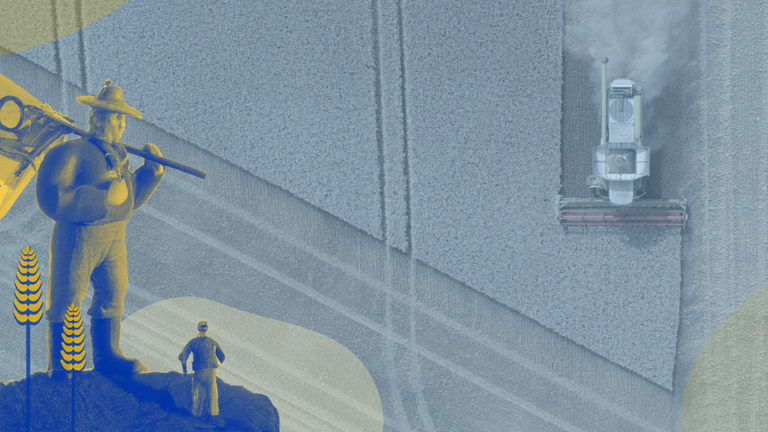The Big Ones Profit, the Small Ones Die
The EU spends the most money on agricultural subsidies. But where does the money end up? We have collected detailed data from recent years and analysed it with our national and international media partners.

Unsplash, Montage: FragDenStaat
Half of Germany consists of agricultural land. There are 16.6 million hectares of fields for wheat, meadows for fruit trees and pastures for livestock. However, the number of farmers cultivating this land is continuously decreasing. About 3,500 farms close down every year, mainly small to medium-sized farms. Large farms that continue to exist benefit – not only from more yield area, but also from more subsidies.
The EU spends more than a third of its budget on agricultural subsidies every year. It is the largest item in the budget - and one of the most controversial. To get a feel for these sums, our Tech Lead Stefan Wehrmeyer, together with Arena for Journalism in Europe and data journalist Simon Wörpel, has collected all the data on EU agricultural subsidies over the past ten years. Now, for the first time, it has been compiled in one place who received how much money for what purpose.
In cooperation with WDR, NDR, Süddeutsche Zeitung, Correctiv, Der Standard, IrpiMedia, Reporter.lu, Reporters United, Expresso, Follow the Money and Gazeta Wyborcza, we have analysed the data from both national and international perspectives. The result: The money does not arrive where it is needed by consumers and the environment. The reason for this is the EU's distribution system.
More hectares, more money
The distribution of subsidies consists of two pillars. The first pillar consists of direct payments for farmers, the second of subsidies for "rural development". The latter is very broad and in Germany also includes, for example, payments to state ministries for flood protection.
Direct payments to farmers are intended to compensate for losses incurred in the sale of agricultural products, for example due to low market prices. The amount is calculated per hectare of agricultural land. So if you have more, you get more. In daily work, however, it makes a considerable difference how large a farm is. Those with more land usually have the corresponding machinery - and thus need less labour. Usually, the economic yield is also higher on large fields where only one crop grows.
Small farmers cannot survive on the sale of their agricultural products alone. They are dependent on subsidies. In small-scale farming, up to two-thirds of income comes from subsidies. At the same time, these small farms are essential for promoting structural change in agriculture.
Together with Correctiv data journalist Max Donheiser, we looked at the size of the farms that leave the subsidy system each year. It turns out that on average they are smaller than those that continue to receive subsidies. Those that stay in the system benefit from it. This is because the total amount of money remains the same and does not adjust to the number of recipients.
Our international partners also come to the conclusion for their respective countries: it is the big ones who profit. However, it is also these large farms that are holding back the transformation in agriculture that scientists say is so urgently needed to mitigate the consequences of climate change.
How it all started
The Common Agricultural Policy (CAP) is one of the oldest policies at European level. It came into force in 1962. The initial idea was primarily to boost agricultural productivity through a price guarantee in order to secure food needs in post-war Europe. This goal was quickly achieved; Europe's agriculture produced food in surplus. However, farmers' profits stagnated.
So in the 1970s there was a change of direction that was more oriented towards the economic return of the farms than towards the needs of the population. Farms were to become larger and thus produce more efficiently and at the same time sell more cheaply. This course still dominates European agricultural policy today. The result: industrial agriculture oriented towards the world market is rewarded. The losers are organic farms and consumers.
In Germany, for example, more pork, milk and wheat are produced than can be bought or eaten. In return, there is not enough domestic fruit and vegetables. Less than a quarter of the demand can be met by German agriculture. All of this is then imported again.
The last decade has shown that a change in agricultural subsidies is essential. In order to curb the effects of climate change, the protection of species, nature and the environment must come to the fore. The Russian invasion of Ukraine and the resulting price fluctuations have also made it clear how important it is not to depend on global supply chains and instead to rely on regional production. But the necessary adjustments have only been made moderately.
Climate policy: well-intentioned
In 2014, the EU adopted regulations for the first time, which were to take into account above all "climate change, animal welfare, food safety and sustainable use of natural resources". The so-called "greening" was introduced. Since then, conditions such as the cultivation of various plants and the preservation of permanent grassland have to be fulfilled in order to receive any money at all from the EU.
But this has not really brought anything. A study commissioned by the Federal Environment Agency comes to a sobering conclusion about what has changed since 2014 as a result of greening:
„Although the loss of land has been stemmed, greening has not contributed to species protection and crop diversification, among other things. Likewise, many measures, such as the provision of fallow land and flower strips, are not sufficiently implemented. Toxic pesticides continue to be used and there is still a nitrogen surplus in agricultural soils."
In January 2023, the rules for awarding agricultural subsidies will be renewed. Green and sustainable is now the credo. The EU wants to increase the share of organic farms to at least 25 percent - Germany has even set a target of 30 percent. This is to be achieved by abolishing the greening premium and introducing so-called eco-schemes, one-year voluntary measures.
In order to implement this, the EU member states will be given more autonomy in the allocation of subsidies. They must draw up "National Strategy Plans" based on previously conducted situation analyses. These plans are then examined and approved by the EU Commission. The EU advises the member states to base their plans on central lines of the so-called Green Deal: Less pesticides, more green spaces and a promotion to switch to organic farming. However, this is not obligatory.
After the member states submitted their plans, the EU Commission itself was not very convinced of the success of the reform. In internal letters from the summer of 2022, published by the NGO Arc2020, it wrote of less than satisfactory results. The system had hardly improved in terms of environmentally friendly agriculture.
A little greener, that’s all
The verdict of the organic farmers is even gloomier than that of the EU. "Climate change and species extinction dramatically show us how urgently we need a transformation of agriculture. But in terms of subsidy policy we are still stuck in the post-war era, as it were, when after the famine years the focus was solely on the highest yield - without regard for losses," says Hubert Heigl, President of Naturland, the association for organic farming, who has switched from conventional to organic farming himself. "We need a funding policy that focuses on the protection of our livelihoods."
Even the Federal Ministry of Agriculture saw a need for action in the recent past. The previous government had followed the principle of "grow or weaken", a ministry spokesman wrote in response to a question. In the meantime, however, the policy has reacted and made adjustments, it now says. The ministry supports the "necessary transformation process in agriculture" and promotes an "ecologically sustainable agricultural economy".
The president of Naturland has little to say about this positive conclusion. According to Hubert Heigl, the new standards would not bring any improvement, but only minimally limit the damage to conventional agriculture. Organic farms would continue to be financially disadvantaged. "At most, the system is designed to make conventional farming perhaps a little greener. But no active incentive is given to switch to organic farming," says Heigl.
It is complicated
Over the years, the system of agricultural subsidies has become increasingly complex. Getting an overview feels like filing a tax return for a complex web of companies - with all the loopholes you don't know about. Moreover, there is no tax advisor at your side, but you have to fit this desk work in between going to the barn in the morning, tilling the fields in the afternoon and going to the barn in the evening.
"It is simply an insane amount of taxpayers' money that is being spent. And it is mainly big landowners who benefit," says Karl Bär, who sits in the Bundestag for the Greens. "The reforms of recent years have neither stopped structural change nor solved the environmental problems, but made the system even more complex and even more bureaucratic." His proposal is therefore to abolish the system of direct payments, which are calculated by hectares of land. Instead, only farms and projects that really contribute to climate and environmental protection should be supported.
The Federal Ministry of Agriculture, which has been under Green leadership since the new legislature, is also looking to the future in this regard, responding to a press enquiry: "In addition, European funding policy will be put to the test with a view to the next funding period from 2027, in order to adequately replace the system of direct payments by rewarding climate and environmental services."
How many small farms will have to cease operations by then remains questionable.
The data on Farmubsidy.org has been collected over the past years by FragDenStaat in cooperation with Arena for Journalism in Europe and has now been jointly analysed by NDR, WDR, Süddeutsche Zeitung, CORRECTIV, Der Standard, IrpiMedia, Reporter.lu, Reporters United Greece, Expresso, Follow The Money and Gazeta Wyborcza.
This article is available in other languages.
